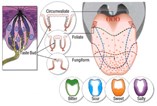Taste Perception Differs Fundamentally from Olfaction According to Research at UCSD

In 1999, Zuker and Nicholas Ryba of the NIDCR identified a set of proteins (T1R1 and T1R2) that had the characteristics expected of taste receptors—that is, they resembled known sensory genes and were expressed in patches in the tongue. But two receptors seemed far too few to handle the huge number of chemicals that produce sweet and bitter substances. Furthermore, T1R1 and T1R2 were not found in the same places as gustducin, a coupling protein critical in sending the bitter signal from taste buds to the brain.

Map of the tongue's taste receptors. Illustration: Charles Zuker/HHMI at the University of California, San Diego.
So the researchers set out to find more taste receptor genes, focusing their efforts on chromosomal regions in humans and rodents known to be involved with taste perception, specifically the perception of bitter. They found, clustered near those chromosomal sites, families of between 40 to 80 G-protein coupled receptors. These newly discovered proteins, which they called T2Rs, appear to be just what they were looking for. They are expressed in subsets of taste receptors, and unlike T1R1 and T1R2, they are exclusively expressed on cells with gustducin, suggesting that they function as gustducin-linked receptors.
The researchers then turned to in vitro systems to see whether these proteins could do the work of a taste receptor. Using a heterologous expression system, they showed that a mouse T2R (mT2R-5) responds to the bitter tastant cycloheximide, and a human and a mouse receptor (hT2R-4 and mT2R-8) responded to denatonium and 6-n-propyl-2-thiouracil. In addition, mutant mice strains unable to detect cycloheximide have amino acid substitutions in the mT2R-5 gene that render the receptor less responsive to cycloheximide in the in vitro system.
What's truly extraordinary here is that unlike the situation with olfaction in which each olfactory cell bears but a single receptor, each cell in the tongue expressed a large repertoire of receptors on its surface. This observation can explain, on a molecular level, the logic behind taste perception and how it differs fundamentally from olfaction. The olfactory system is designed to recognize a wide range of odors and to discriminate one odor from another—and can be exquisitely sensitive to subtle differences. This need is reflected in the organization of the olfactory system, with each olfactory neuron expressing only one of the 1,000 or so olfactory receptor genes.
Taste can be viewed differently, however, especially where bitter compounds are concerned. Virtually every naturally occurring toxin tastes bitter, "so bitterness clearly evolved with the sole purpose of warning you against the ingestion of toxic substances," says Zuker. It's critically important to recognize and reject anything bitter, not to get hung up on distinctions among different compounds. And in fact, experiments with humans have shown that we are unable to discriminate one bitter substance from another.
Zuker is confident that they have identified at least a subset of bitter taste receptors and will further this work by tracing pathways from receptor cells to the brain, generating "knockout" mice that lack T2Rs and studying their taste deficits, and searching for more gustducin-linked receptors.
References
Elliot Adler, Mark A. Hoon, Ken L. Mueller, Jayaram Chandrashekar, Nicholas J. P. Ryba, and Charles S. Zuker, "A Novel Family of Mammalian taste Receptors," Cell, 100, 693–702, March, 2000,
Jayaram Chandrashekar, Ken L. Mueller, Mark A. Hoon, Elliot Adler, Luxin Feng, Wei Guo, Charles S. Zuker, and Nicholas J. P. Ryba, "T2Rs Function as Bitter Taste Receptors," Cell 100: 703–11, March, 2000.
For more information: Charles S. Zuker, Department of Biology, University of California, San Diego, La Jolla, CA 92093. Tel: 858-534-7728. Fax: 858-534-8510. Email: czuker@flyeye.ucsd.edu.
